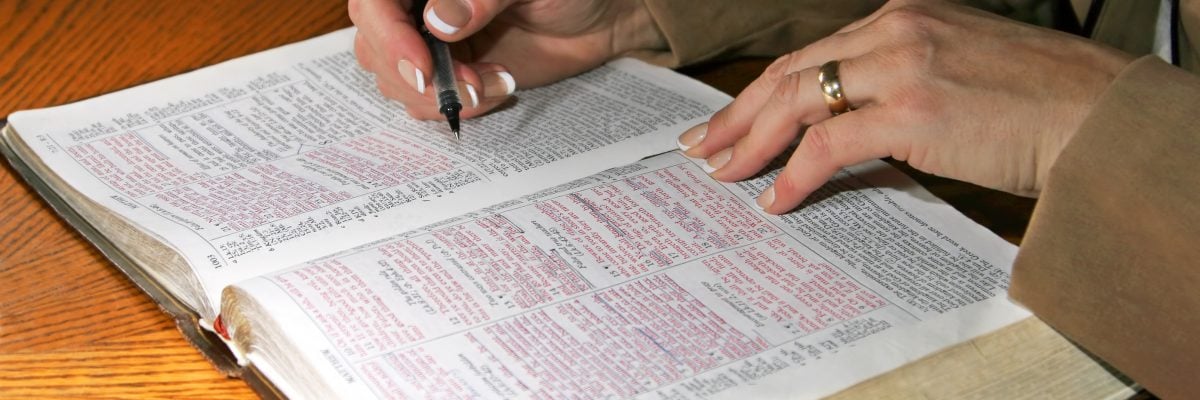
Choosing a study Bible is a lot easier for Catholics than it is for Protestants!
This is because there are fewer translations that contain the full canon of Scripture (including the deuterocanonical books of the Old Testament), and the number of such bibles that include study tools is smaller. This is unsurprising; the large selection of Protestant study bibles reflects the number and diversity of Protestant beliefs.
That said, there exists a spectrum of Catholic study bibles created by the scriptural translations and study tools. Although their differences present nothing like the range of options found in Protestantism, they can be important nonetheless. Let me share some thoughts on the most readily available Catholic study bibles on the market today.
First, let’s look at the three contemporary Catholic Scripture translations that are used for most Catholic study bibles.
The New American Bible—Revised Edition (NABRE)
The New American Bible was the first Catholic translation made directly from the original biblical languages (rather than from the Latin Vulgate). When the Old Testament was revised, it was officially replaced by the New American Bible Revised Edition. The NABRE is a “formal equivalent” translation, which means it is not a literal word-for-word rendering of the original text but not a paraphrase either. The translation is most notably criticized for its avoidance of gender-indicative terminology whenever possible, including references to God.
Some conservative Catholics have also criticized the translation’s notes, which reflect many modern critical theories concerning the Bible’s origins (such as assigning late dates to biblical writings, claiming that some books are pseudonymous, affirming the JEPD theory of mosaic authorship and the “Q” gospel, and even suggesting that the Gospel writers modified historical truths to suit their agendas). This is an important consideration, because every edition of the NABRE is required have the same footnotes. So whether it is a simple pew Bible, a youth Bible, or a full-sized family Bible, readers get the same notes.
The Revised Standard Version (RSV2CE)
The Revised Standard Version is a 1950s-era revision of the King James Version (the RSV Catholic Second Edition includes the deuterocanonical books). It is a literal, word-for-word translation that uses “King James English” (“thee” and “thou”) when addressing God, but is otherwise translated into today’s English. Unlike the NABRE or the RSV’s modern revision, the New Revised Standard Version, the RSV is not “gender-inclusive” and it translates pronouns and other gender-indicative words according to the original text (for example, it does not add “and sisters” to the original word for “brothers”). The RSV is both a common choice among scholars and one of the most beautiful English translation of the Bible available today. The RSV has no notes that go along with the translation, so different study Bibles exist based on the translation.
The New Jerusalem Bible (NJB)
The New Jerusalem Bible is the 1985 update to the 1966 Jerusalem Bible—a translation that itself is based on the French La Bible de Jérusalem translated by the faculty of the Dominican Biblical School in Jerusalem. The original translation was mixed bag: literal in some respects, but with a loosely translated Old Testament text made up of a combination of various textual traditions. The NJB, however, is not based on this French translation but on the original biblical languages. It is fairly literal, but includes some intriguing poetical influences (including translation work by J.R.R. Tolkien on the book of Jonah!). Another rarity is the NJB’s transliteration of the divine name (the Hebrew tetragrammaton) as “Yahweh.” The NJB comes with its own set of notes, and these reflect a mix of traditional and critical approaches.
Once you have chosen a preferred translation, it’s time to look at the available study tools.
The Catholic Study Bible [NABRE]
Because The (Oxford) Catholic Study Bible uses the NABRE translation, its notes are the same as any other NABRE Bible. What it adds is a whopping 525-page introduction to Scripture consisting of general Bible information and mini-commentary “Reading Guides” for all the books. These are written by many prominent biblical scholars, featuring the same kind of modern-higher-critical opinions that the NABRE notes do. Although the guides are (somewhat annoyingly) set apart from the books they comment on, they are helpfully cross-referenced to the biblical text (and vice-versa). Additional materials include several in-text essays, a glossary, biblical weights and measures, lectionary, index, concordance, and maps.
The Didache Study Bible [RSV2CE]
The Didache Study Bible is offered in the RSV as well as the NABRE. The title and study notes were inspired by the Midwest Theological Forum’s Didache series of religious education textbooks, and are very often based on the Catechism of the Catholic Church. The notes and essays (which fall on a spectrum of traditional Catholic teaching) are non-academic, but certainly not anti-intellectual or overly “spiritual.” There are over a hundred apologetic essays answering common questions about the Catholic faith. It also includes a biblical reading guide, theme summary, chronology, maps, glossary, and topical index.
The Ignatius Catholic Study Bible [RSV2CE]
The Ignatius Catholic Study Bible is based on the RSV translation with notes written by renowned Bible scholar Scott Hahn and his student Curtis Mitch. The notes present a refreshingly fair and unique balance of traditional-orthodox and modern-critical viewpoints. In addition, topical essays and word studies include interpretations from the Fathers of the Church, the Catholic Magisterium, and faithful Catholic scholars. Each book is outlined and introduced with an essay covering authorship, date of writing, original audience, and general themes. It also includes a doctrinal index, concordance, cross-reference system, and various maps and charts.
The New Jerusalem Bible [NJB]
Although it is not marketed as such, the New Jerusalem Bible contains many common features of study bibles. It has a great cross-reference system and extensive notes. The Old Testament notes reflect modern critical scholarship (JEPD, late dates, pseudonymous writings, etc.); however, the New Testament notes are more traditional (rejecting Markan priority and “Q,” for example), though not completely traditional (2 Peter is said to be pseudonymous).
How to Choose?
Your choice of a Catholic study Bible will best be made by considering what each one offers and weighing the strengths and weaknesses of each.
If you wish to have the best traditional, orthodox study notes, the Ignatius Catholic Study Bible is hard to beat. The Didache Bible is a close second. Both feature the top-notch RSV translation and their notes are generally faithful to Church tradition.
The Catholic Study Bible features a translation close to what is used in Mass and contains the largest collection of study tools in a single volume. The NABRE’s modern-critical notes can serve as a good resource so long as they are understood for what they are. And the New Jerusalem Bible is an interesting—if not academically trustworthy—translation, with notes that reflect a mixture of traditional and modern views.
One additional resource that should not be overlooked is the Navarre Bible, which was inspired by the founder of Opus Dei, St. Josemaria Escriva. Its faithful and extensive notes utilize official Church documents, the early Fathers and Doctors of the Church, as well as contemporary Catholic theologians and Church documents. Although a highly-respected and sought-after resource, it is difficult to count the Navarre as a study Bible, however, for it is published more like a commentary set. Only the New Testament can be purchased as a single volume, while the Old Testament books constitute a seven-volume set.
Whichever you choose, be glad that these good choices exist, and remember that the best Catholic study Bible is the one you read!



